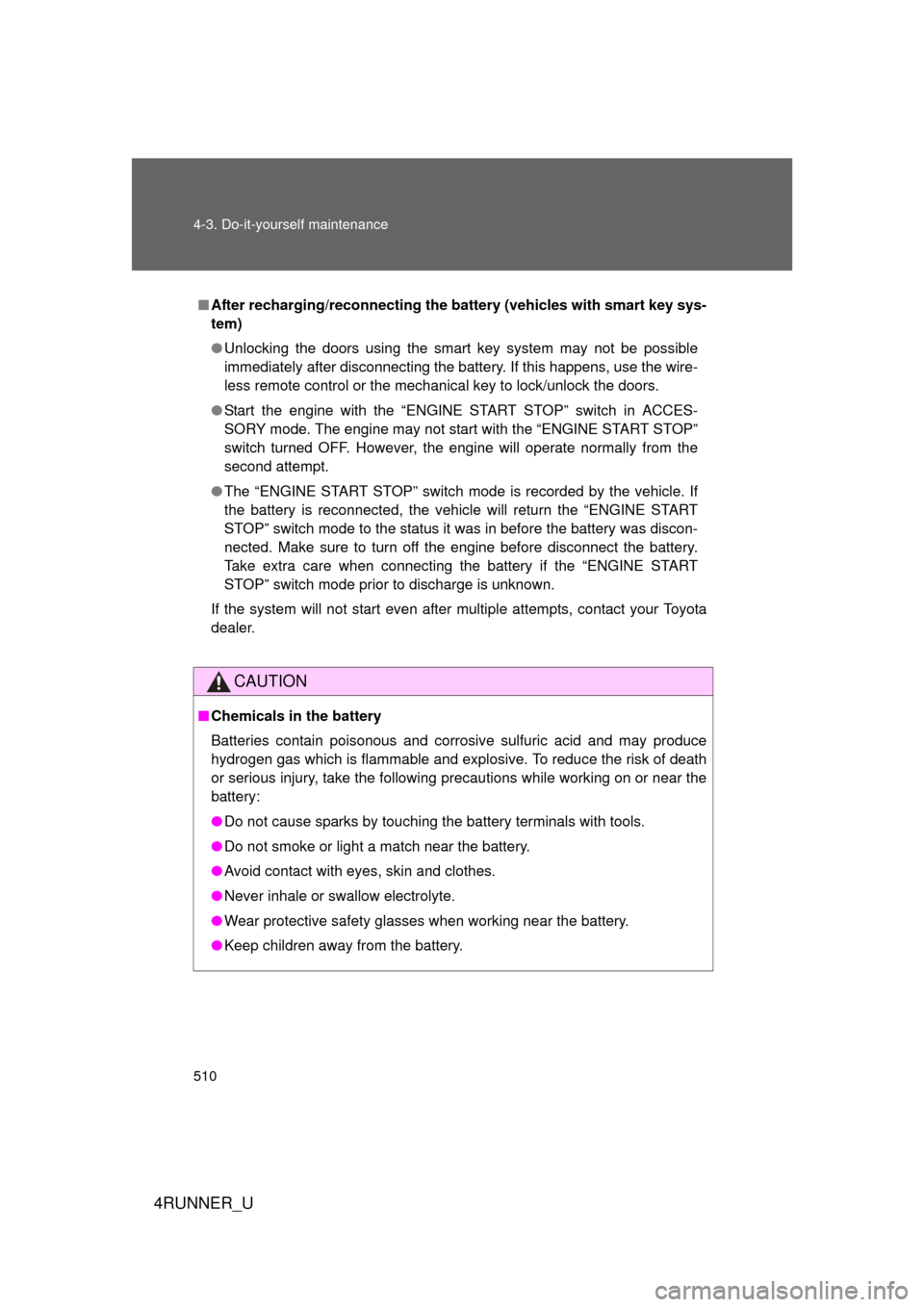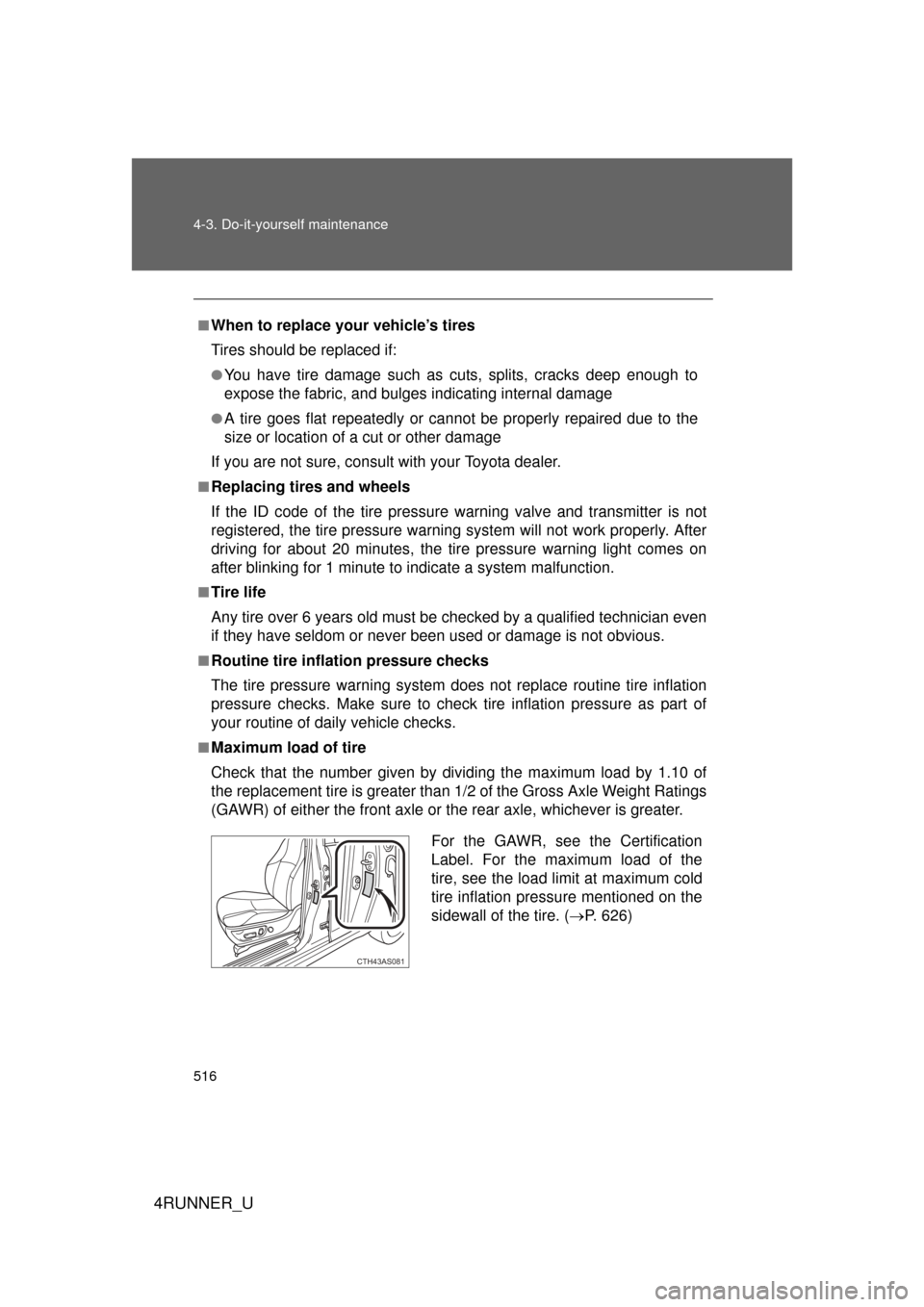Page 495 of 665
494
4-3. Do-it-yourself maintenance
4RUNNER_U
Hood
CAUTION
■Pre-driving check
Check that the hood is fully closed and locked.
If the hood is not locked properly, it may open while the vehicle is in motion
and cause an accident, which may result in death or serious injury.
Release the lock from the inside of the vehicle to open the hood.
Pull the hood release lever.
The hood will pop up slightly.
Pull up the auxiliary catch
lever and lift the hood.
CTH43AS009
STEP 1
CTH43AS087
STEP 2
Page 507 of 665
506 4-3. Do-it-yourself maintenance
4RUNNER_U
■Brake fluid can absorb moisture from the air
Excess moisture in the brake fluid can cause a dangerous loss of braking
efficiency. Use only newly opened brake fluid.
CAUTION
■When filling the reservoir
Take care as brake fluid can harm your hands and eyes and damage painted
surfaces.
If fluid gets on your hands or in your eyes, flush the affected area with clean
water immediately.
If you still experience discomfort, see a doctor.
NOTICE
■If the fluid level is low or high
It is normal for the brake fluid level to go down slightly as the brake pads
wear out or when the fluid level in the accumulator is high.
If the reservoir needs frequent refilling, there may be a serious proble\
m.
Page 508 of 665
507
4-3. Do-it-yourself maintenance
4
Maintenance and care
4RUNNER_U
Power steering fluid
■ Fluid level
The fluid level should be within the appropriate range.
2.7 L 4-cylinder (2TR-FE) engine
Full (when cold)
Add fluid (when cold)
Full (when hot)
Add fluid (when hot)
4.0 L V6 (1GR-FE) engine Full (when cold)
Add fluid (when cold)
Full (when hot)
Add fluid (when hot)
Hot: Vehicle has been driven around 50 mph (80 km/h) for 20 minutes, or slightly longer in frigid temperatures. (Fluid tem-
perature, 140°F - 175°F [60°C - 80°C]).
Cold: Engine has not been run for about 5 hours. (Room tempera- ture, 50°F - 85°F [10°C - 30°C]).
CTH43AS130
CTH43AS016
Page 511 of 665

510 4-3. Do-it-yourself maintenance
4RUNNER_U
■After recharging/reconnecting the battery (vehicles with smart key sys-
tem)
● Unlocking the doors using the smart key system may not be possible
immediately after disconnecting the battery. If this happens, use the wire-
less remote control or the mechanical key to lock/unlock the doors.
● Start the engine with the “ENGINE START STOP” switch in ACCES-
SORY mode. The engine may not start with the “ENGINE START STOP”
switch turned OFF. However, the engine will operate normally from the
second attempt.
● The “ENGINE START STOP” switch mode is recorded by the vehicle. If
the battery is reconnected, the vehicle will return the “ENGINE START
STOP” switch mode to the status it was in before the battery was discon-
nected. Make sure to turn off the engine before disconnect the battery.
Take extra care when connecting the battery if the “ENGINE START
STOP” switch mode prior to discharge is unknown.
If the system will not start even after multiple attempts, contact your Toyota
dealer.
CAUTION
■ Chemicals in the battery
Batteries contain poisonous and corrosive sulfuric acid and may produce
hydrogen gas which is flammable and explosive. To reduce the risk of death
or serious injury, take the following precautions while working on or near the
battery:
● Do not cause sparks by touching the battery terminals with tools.
● Do not smoke or light a match near the battery.
● Avoid contact with eyes, skin and clothes.
● Never inhale or swallow electrolyte.
● Wear protective safety glasses when working near the battery.
● Keep children away from the battery.
Page 513 of 665
512 4-3. Do-it-yourself maintenance
4RUNNER_U
Washer fluidTy p e A If any washer does not work or
the low washer fluid warning light
comes on, the washer tank may
be empty. Add washer fluid.
Ty p e B If the washer fluid level is at
“LOW ” , add washer fluid.
CTH43AS119
CTH43AS071
CAUTION
■When adding washer fluid
Do not add washer fluid when the engine is hot or running as washer fluid
contains alcohol and may catch fire if spilled on the engine etc.
Page 517 of 665

516 4-3. Do-it-yourself maintenance
4RUNNER_U
■When to replace your vehicle’s tires
Tires should be replaced if:
●You have tire damage such as cuts, splits, cracks deep enough to
expose the fabric, and bulges indicating internal damage
●A tire goes flat repeatedly or cannot be properly repaired due to the
size or location of a cut or other damage
If you are not sure, consult with your Toyota dealer.
■Replacing tires and wheels
If the ID code of the tire pressure warning valve and transmitter is not
registered, the tire pre ssure warning system will not work properly. After
driving for about 20 minutes, the ti re pressure warning light comes on
after blinking for 1 minute to indicate a system malfunction.
■Tire life
Any tire over 6 years old must be checked by a qualified technician even
if they have seldom or never been used or damage is not obvious.
■Routine tire inflation pressure checks
The tire pressure warning system doe s not replace routine tire inflation
pressure checks. Make sure to check tire inflation pressure as part of
your routine of daily vehicle checks.
■Maximum load of tire
Check that the number given by di viding the maximum load by 1.10 of
the replacement tire is greater than 1/2 of the Gross Axle Weight Ratings
(GAWR) of either the front axle or the rear axle, whichever is greater.
For the GAWR, see the Certification
Label. For the maximum load of the
tire, see the load limit at maximum cold
tire inflation pressure mentioned on the
sidewall of the tire. (P. 626)
CTH43AS081
Page 536 of 665
535
4-3. Do-it-yourself maintenance
4
Maintenance and care
4RUNNER_U
Fuse layout and amperage ratings
■ Engine compartment
FuseAmpereCircuit
1PTC HTR NO.330 A
PTC heater
2DEF30 ARear window defogger
3DEICER 20 A
Windshield wiper de-icer
4PTC HTR NO.230 APTC heater
5SUB BATT30 ATrailer sub battery
6PTC HTR NO.150 A
PTC heater
7MIR HTR10 AOutside rear view mirror defog-
gers
8TOWING TAIL30 A
Trailer tail light
9A/C COMP10 AAir conditioning system
10STOP10 A
Stop/tail lights
11IG220 AINJ, IGN, GAUGE fuses
12HORN10 AHorn(s)
13EFI 25 AMultiport fuel injection system/
sequential multiport fuel injec-
tion system
14A/F20 A
A/F sensor
CTH43AS079
Page 537 of 665

536 4-3. Do-it-yourself maintenance
4RUNNER_U
15H-LP RH-HI10 ARight-hand headlight (high
beam)
16H-LP LH-HI10 ALeft-hand headlight (high
beam)
17HTR50 A
Air conditioning system
18400W INV 80 APower outlets
19ST30 AStarter system
20H-LP HI20 A
H-LP RH-HI, H-LP LH-HI fuses
21ALT-S7.5 A Charging system
22TURN&HAZ15 ATurn signal lights, emergency
flashers
23ETCS10 AMultiport fuel injection system/
sequential multiport fuel injec-
tion system
24TOWING30 A
Trailer stop/turn lights
25SHORT PIN
No circuit
26RAD NO.1 10 A Audio system
27AM27.5 A Starter system
28MAYDAY 7.5 ASafety connect
29AMP30 A
Audio system
30ABS NO.150 AABS, VSC
31ABS NO.230 AABS, VSC
32AIR PMP50 AMultiport fuel injection system/
sequential multiport fuel injec-
tion system
33DOME10 A
Interior lights, vanity lights
34ECU-B10 AMultiplex communication sys-
tem, meter and gauge
35H-LP RH-LO10 ARight-hand headlight (low
beam)
36H-LP LH-LO10 A
Left-hand headlight (low beam)
37INJ10 AMultiport fuel injection system/
sequential multiport fuel injec-
tion system
FuseAmpereCircuit